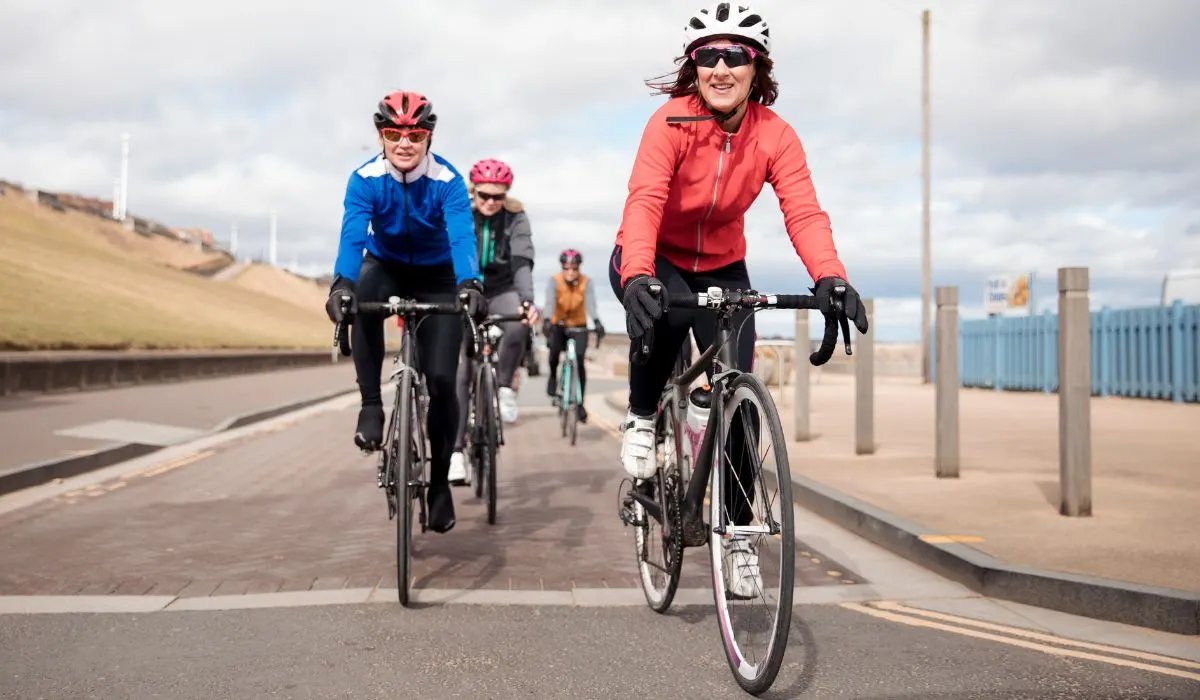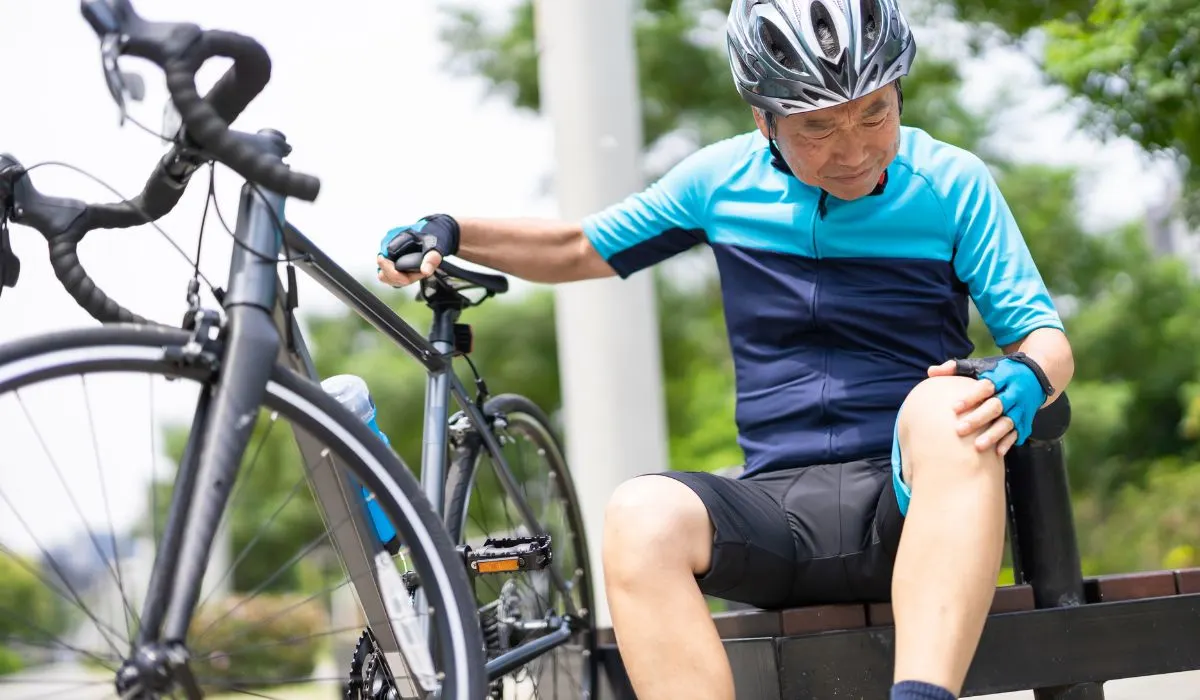
Cycling is a great way to get the much-needed aerobic exercise that allows you to get outdoors and enjoy being one with nature. It also has many health benefits. However, as with most things, cycling has its drawbacks. So, what are the pros and cons of cycling, and is it the best option overall?
Cycling enhances many things, such as:
- mental health
- aids in weight loss
- improves lung health
- increases muscle
- lowers the risk of cancer and cardiac disease
- boosts mental capacity
- enhances handling
- widens social circles
On the other hand, cycling is also:
- costly
- time-consuming
- can lead to bone loss and nerve compression
Regular cycling has many health advantages, including a reduction in body fat. Since cycling is mostly aerobic, it works out your:
- heart
- blood flow
- lungs
Your general fitness level will increase because you’ll breathe more deeply and sweat more. Here’s a thorough look at the pros and cons of cycling and whether or not it is the best option.
What Are The Pros Of Cycling?
Cycling is incredibly good for you, and research proves it can improve your life. So, what are the pros of cycling?
Cycling Can Reduce Cardiovascular Disease
As cycling is significantly a low-impact exercise since you’re simply peddling and not creating any impact that is associated with walking or running, it is excellent at improving heart rate.
NOTE: Since you are suspended, your heart gets stimulated without impact on your bones.
Furthermore, cycling strengthens the heart muscles by getting your heart rate up, helping prevent heart disease. This includes preventing:
- high blood pressure
- stroke
- heart attack
Weight Loss Is Possible With Cycling
Cycling is a great way to lose weight and it is known to burn two times the calories of walking for the same amount of time. While cycling, someone can burn anywhere between 80 and 680 calories in a 30-minute session, depending on how fast they peddle.
However, keep in mind that it depends on what your weight is and also how much effort you put into your peddling. If you let the bike’s momentum carry you instead of peddling, you won’t burn that many calories.
NOTE: Research shows that cycling has a significantly faster effect on metabolism, and is more effective at accelerating weight loss.
If you look at how lean pro bike riders are, you’ll certainly understand how cycling can help trim fat from a person’s entire body.
Cycling Has Been Proven To Slow Ageing
This may sound like it is too good to be true. Still, research has proven that high-intensity cycling can, have significant anti-aging benefits at our cellular level. This is due to an increase in mitochondrial capacity.
Those with a decreased mitochondrial capacity experience physical decline. Simply put, the better your mitochondria function, the better they can work, and the more rejuvenated you will be starting at your cellular level.
Cycling Reduces Stress
In today’s world, it is fairly easy to feel stressed as the standard of living increases and unexpected expenses pop up everywhere. Ever heard of the term runners high? Well, it doesn’t only pertain to running, as any exercise can help an individual feel amazing afterward.
An excellent way to help reduce stress is to go cycling, which has important mental health benefits. Biking is one of the most beneficial sports that enhance people’s mental health. It is a form of physical activity that mixes outdoor adventure and sightseeing, providing the rider with joy and calm.
This is because cycling outdoors is enjoyable as you are breathing in the fresh air, exercising, and, most importantly, getting problems off your mind. It also helps balance the adrenaline and cortisol levels in your body.
Attaining the perfect balance between the two will help reduce stress. Cycling is considered the most effective way to reduce stress since your focus is on peddling and breathing, shifting your focus from your anxiety and stress. This kind of freedom is hard to duplicate in a gym or even when doing exercises at home.
Furthermore, it is well-known that heart-pounding exercise releases energy-boosting hormones that aid in you feeling calmer and happier. This is also the case for cycling as it helps release dopamine.
FACT: Dopamine will linger on after you finish cycling and will help improve your mood and energy levels.

Cycling Improves Strength
Because cycling delivers an intense workout, it’s not surprising that it will improve your stamina and your strength. Cycling is a complete body exercise.
Many think cycling only builds leg muscles, but that isn’t the case. Staying balanced and upright while cycling reinforces and engages large groups of muscles.
When you steer a bike, you also build and strengthen your arms and shoulder muscles. Unsurprisingly, your leg muscles take on an important job, as you push against the pedals, it utilizes these muscles:
- butt
- glute
- thighs
- quads
Furthermore, when you are in the upstroke accelerating, you use the hip flexor muscles and hamstrings.
One Can Expect Improved Lung Function When Cycling
Cycling enhances air movement through the lungs. This makes both the lungs and the heart much stronger. Normal lung function significantly declines with age. Breathing problems follow from this, frequently resulting in a lack of drive for further activity.
FUN FACT: Cycling has a reputation for being the Fountain of Youth, known for improving health and lung function.
As we become older, the lungs and heart require fundamental cardiovascular efficiency. Cycling is the ideal activity for achieving this. Cycling provides the body with a much-needed fresh burst of oxygen.
Each breath of air feeds the body’s muscles with oxygenated blood, allowing them to maintain bulk when the lungs are flexible. It goes without saying that a healthy metabolism depends on muscle.
Flexibility Is Increased When You Cycle
Being flexible is super important when it comes to staying fit. Not only that, but it also means that the risk of injury is minimized. If your lower body is stiff and you can’t even touch your toes, cycling is the way to go.
Cycling helps you to maintain flexibility and loosens body parts like the:
- hamstrings
- quadriceps
- calves
You feel lighter when you are more flexible, and your posture and balance improve.

Cycling Is A Low-Impact Exercise
As mentioned above, cycling has zero percent impact. Compared to running or walking, no steps are being taken therefore no small crashes (impact) are being produced. Furthermore, there is no pressure on joints. This applies to both on-the-road biking and even indoor cycling.
When sitting on a bike, your whole body’s weight is placed on your pelvis, whereas walking puts the weight on the:
- knees
- legs
- feet
To further prove how easy cycling is on the joints, elderly people in pain have been known to improve their condition by cycling. This means that cycling is gentle on the body but still gets the job done.
Cycling Reduces The Risk Of Getting Cancer
When a person takes up activities like cycling, it can significantly reduce the risk of getting cancer. Doing cycling, whether moderate or advanced, in the early and mid-ages reduces the chances of one getting cancer as opposed to those that did not take up cycling.
FACT: Cycling as a form of transportation has been proven to lower cancer risk.
Cycling Improves Brain Power
Interestingly, a person’s mental skills improve after a bike ride. Furthermore, coordination is also improved. You may have heard that the human brain consists of white and grey matter. In the case of cycling, improved brain power has to do with the white matter in the human brain.
As this white matter is a conduit, it means that different regions of the brain are linked together. Those that regularly bike increase the integrity of their white matter. This helps their brain function more smoothly than those that do not cycle.
Your Immune System Is Boosted When You Cycle
Cycling is an excellent way to help your body fight off any viruses that want to invade your body and make you sick. The thymus organ’s function is to protect your immune cells. However, as you reach the age of 20, that organ shrinks which leads to a decreased immune system of up to 2 to 3 percent every year.
As you reach middle age, the thymus is down a whopping 15% of its original size, leaving the body no choice but to rely on the antibodies it has gained fighting nasty bugs and germs throughout the years. Those that cycle will have a more robust immune system as it leads to increased production of immune cells.
Cycling also helps the body flush out bacteria from areas such as the lungs and airways. This reduces the chances of one catching a cold. The rise in your body temperature when you cycle also helps to prevent bacteria from multiplying and keeps infections at bay.
Cycling Boosts One’s Confidence
It may seem entirely too good to be true, but cycling really does boost a person’s self-confidence. While you cycle, your body releases a serotonin mood neurotransmitter. Wondering what this does?
It helps you stay confident and stable not only physically but emotionally too. Cycling induces:
- self-esteem
- positivity
- self-confidence

Cycling Helps People Sleep Better
I am not sure about you, but a good night’s sleep always puts me in a better mood. A study was conducted where those that suffered from insomnia were asked to cycle for 20 to 30 minutes every other day.
Results proved that cycling decreased the time it took for those individuals to fall asleep. Cycling outside is imperative as it exposes you to daylight. This, in turn, gets the circadian rhythm back into sync. It also rids the body of cortisol, a stress hormone that harms sleep.
Cycling Is A Sociable Exercise
Since we can ride with friends, relatives, or even complete strangers in groups, cycling can be a social activity that:
- enhances our social lives
- enables us to meet new people
- fosters a sense of community
As with walking, you can choose to do it as a group. It can basically be a family outing where everyone gets in some exercise and spend time together.
You don’t have to cycle alone. This applies to both indoor cycling as well as on-road riding. Furthermore, you will always come across other cyclists and can build new friendships. Anyone and everyone can join in! Once you learn how to ride a bike, forgetting is impossible.
Longevity Is Increased When An Individual Cycles
According to research carried out on Tour de France cyclists, the riders had increased longevity. Those that had previously participated in the sport tended to live to 81 on average compared to the general population’s 73 years.
This also applies to casual bike commuters. This means that cycling plays a role in ensuring you live longer. Furthermore, cycling between 1 and 60 minutes a week is guaranteed to reduce early mortality risk by up to 23%.
Cycling Is Good For The Environment
As opposed to driving a car or riding a motorcycle, cycling is pollution free as it does not emit any carbon fumes. It also does not use any carbon fuel or even electricity.
What powers your bike is you. This means that every time you ride a bike to get some exercise in, you are doing a good thing for the environment.
Cycling Is Incredibly Easy And Simple
Cycling is simple since it doesn’t require much physical prowess, unlike some other sports. Just about any individual can ride a bike, and once you learn, you never forget it. Cycling can be as severe as you like.
NOTE: If you are recovering from an illness or injury, you can start at a very low level and work your way up to more strenuous physical activity.
One of the most popular exercises in gyms and fitness facilities throughout the globe is indoor cycling. Cycling is feasible because most people may begin an indoor cycling program, irrespective of their physical condition and starting state.
What Are The Cons Of Cycling?
Although cycling is considered a great, low-impact exercise that allows you to get fresh air and some vitamin D, it isn’t without its cons if you choose to cycle outdoors. It can have some side effects.
Many recreational riders are unaware of the side effects that come with cycling. However, fear not, as there are very few drawbacks to cycling. So, what are the cons of cycling?

The Initial And Related Costs Of Cycling Are Expensive
It’s hardly unexpected that many people are looking for affordable and practical cardio exercise. Cycling has both upfront and continuing costs.
NOTE: Depending on the brand and type, the initial cost of purchasing a bicycle might be quite high, especially if you’re seeking a high-quality bike.
Then there are other supplementary expenses like safety equipment. For protection in case of accidents, you must wear a helmet like this one sold on Amazon.
Lights are a wise purchase, especially if you intend to bike late at night or early morning. These bike lights sold on Amazon are great value.
Another item that you will need to budget for is clothing. These include things like gloves and cushioned shorts (both links take you to the product on Amazon).
In order to be prepared for any possible accidents or injuries, you will need to buy a repair kit like this one on Amazon. Don’t forget the routine maintenance your bike will require to stay in top functioning and cosmetic shape. Additionally, keep in mind the possibility of replacing any parts.
Cycling Can Lead To Nerve And Artery Compression
It has been noted that some riders experience numbness and other negative effects from cycling after they have been doing it for a long time. However, fear not, as these are avoidable and can be reversed.
Cycling Is Time Consuming
Whereas you can simply walk out for a leisurely stroll, cycling requires some preparation which can be time-consuming. You must prepare before you go cycling. You must get your bike and ensure everything is in working order. Additionally, you’ll need to dress appropriately.
Cycling Often Leads To Upper And Lower Back Pain
As you have probably noticed, cyclists often have to hunch over to reach the handlebars. This isn’t a healthy posture when not done right, as it can cause stress on the upper and lower back and will lead to either tightness or pain.
Cycling Leads To Bone Loss
As mentioned above, cycling is a low-impact exercise. You would think that this is a good thing. However, it does have a fairly significant drawback: those that cycle can experience bone loss.
Bone loss is unique to cycling, as other athletes do not experience it since other sports have varying percentages of impact on an individual’s bones.
Cycling In The Road Can Be Dangerous
Although indoor cycling is safe and much more practical, an outside cycling plan carries some dangers. It is easy for your bike to slip and fall, leading to you getting injured when outdoors.

There are also cars, and the chances of accidents happening are somewhat high as not everyone is vigilant.
Furthermore, things can fly into your eyes while you’re cycling outdoors. This can affect your vision temporarily, leaving you vulnerable to injury.
The danger of accidents and exposure to allergies may be greater for cyclists who ride outside.
NOTE: This does not apply to indoor cycling.
Is Cycling The Best Exercise Option?
Theoretically, any aerobic exercise is beneficial and interchangeable. Running provides similar strong aerobic benefits as biking, but biking carries a significantly lower risk of joint damage than running.
FACT: Although walking is a great exercise, it is not intense enough to build a healthy cardiovascular system.
Cycling offers the most distinctive advantages over other forms of exercise since it is mentally exciting to encounter a wide variety of surroundings with little physical effort. In other words, cycling never gets dull, unlike:
- walking
- running
- spinning
- weight lifting
It’s liberating and energizing to be able to move fast through space and fly almost like a bird. That is what distinguishes cycling.
A person should be physically active if they want to be healthy and fit. By regularly engaging in physical activity, you can ward off serious illnesses like:
- diabetes
- heart disease
- cancer
- mental problems
- hypertension
- arthritis
One of the easiest methods to lower your risk of health issues linked to an inactive lifestyle is to ride your bicycle. Young kids to senior citizens can all benefit from cycling as a safe, low-impact form of exercise. It is also enjoyable and environmentally friendly.
Cycling is much less damaging to your body than running, so you can continue participating in it for the rest of your life without experiencing the same injuries other people sustain when doing other types of sports.
Conclusion
Cycling is advantageous since it trains your quads, hamstrings, and calf muscles without requiring you to bear any weight. It increases endurance while also strengthening your legs. However, it isn’t without drawbacks.
That being said, it doesn’t have many cons like other sporting activities. Furthermore, cycling is the best option when it comes to you getting a full-body workout. Not only that, but its numerous benefits are quite hard to beat!
You might also be interested in:
